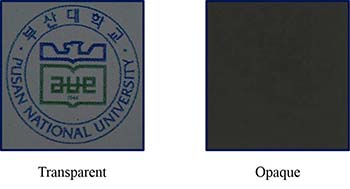
Dye-doped PNLC cell in transparent and opaque states. Credit: T.-H. Yoon / Pusan Natl. Univ.
Researchers from Pusan National University (Korea) have proposed a new, transparent light shutter made from crossed-patterned electrodes and polymer-networked liquid crystals (PNLC) doped with dichroic dyes (API Advances, doi: 10.1063/1.4918277). The lab-tested design runs on low voltage, offers high-visibility, and can be quickly switched between opaque and transparent states. The technology could be applied to see-through displays and smart windows in cars, buildings and airplanes.
Most research on transparent displays is focused on organic light emitting diodes (OLEDs). However, the see-through portion of an OLED pixel is fixed open, allowing the background light to come through, which reduces display visibility. While traditional light shutters offer better visibility than OLEDs, shutter designs based on liquid crystals that absorb light can’t completely block the background, and those based on crystals that scatter light can’t provide a black color. Current light shutters also suffer from sluggish response times and require a high and continuous operating voltage.
The Pusan National University researchers, led by Tae-Hoon Yoon, fabricated and experimentally tested a new transparent light shutter design that can both absorb and scatter light. The cell consists of a mixture of polymer-networked liquid crystals and dichroic dyes between cross-patterned electrodes. Oncoming light is scattered by the randomly oriented liquid crystals in the polymer network. When power is applied to the electrodes, it creates an electrical field that aligns the light-absorbing dichroic dye with oncoming light.
The degree of light absorption can be controlled by rotating the dye molecules. When the absorption of oncoming light is complete, the display appears opaque and can provide a black color. The electric current speeds up switching time, eliminating the need to wait for the crystals to “relax” to an off position. The PNLC cell’s voltage requirements are low because electricity is only needed when the cells are on.
Next, the researchers want to increase and decrease the PNLC cell’s transmittance at transparent and opaque states, and develop a bi-stable light shutter that only consumes electricity when switching states.
